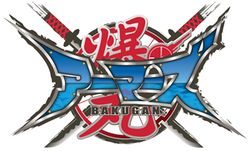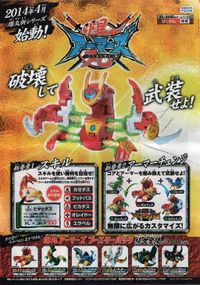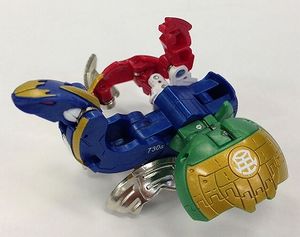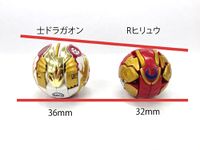Bakugan Armors
| Main | Gallery |
Bakugan Armors (爆丸アーマーズ, Bakugan Āmāzu?) is the third series of the Bakugan franchise after BakuTech. The first wave of products was released on April 5, 2014. In the Bakugan Reference Book, Bakugan from this series are marked in blue indicating that they are also considered as BakuTech.
Contents
Bakugan Armor System
Bakugan Armor System is a new type of connecting details to each Bakugan of that type.
Each Bakugan Armors has a base body called Core (コア, Koa?) that can accommodate three interchangeable type of parts
- Skill Arm (スキルアーム, Sukiru Āmu?) - A unique feature exclusive to Bakugan Armors. The interchangeable Left Arm has a Usable Skill which can be used to the player's advantage in battle.
- Attribute Arm (属性アーム, Zokusei Āmu?) - The interchangeable Right Arm carries the Attribute symbol. This is the first time Japanese exclusive Bakugan introduces interchangeable Attribute feature.
- Sole (ソール, Sōru?) - A pair of feet parts that are made in either Metal or Plastic. This is similar with the Convert System.
Useable Skills
The Usable Skills of each Bakugan Armors can be found on its Left Arm which is called the Skill Arm (スキルアーム, Sukiru Āmu?). Each Bakugan Armors has their own unique usable skills.
| Icon | Skill Name | From Bakugan | Description |
|---|---|---|---|
| Plus Hundred (ヒャッタス, Hyatasu?) | Rekka Hiryu | Adds 100G during Power Battle (Power Level + Attribute Gate Card Bonus + 100) | |
| Plus Wind (カゼタス, Kazetasu?) | Shippu Zeku | Adds the Ventus Gate Card Bonus during Power Battle (Power Level + Attribute Gate Card Bonus + Ventus Gate Card Bonus) | |
| Blow Away (フットバス, Fūtobasu?) | Hado Kaio | Allows you to freely move the Bakugan to any Gate Card being occupied by an opponent's Bakugan to trigger a Power Battle. | |
| Plus Light (ピカタス, Pikatasu?) | Ogon Houoh | Adds the Haos Gate Card Bonus during Power Battle (Power Level + Attribute Gate Card Bonus + Haos Gate Card Bonus) | |
| O-raid (オレイドー, Oreidō?) | Koppa Kudaku | Allows you to freely move the Gate Card, where your Bakugan stood, around the field. | |
| Free Select (エラベル, Eraberu?) | Yasha Tagaras | Allows you to freely select which additional Attribute Gate Card bonus to add to the Power Level and the Attribute Arm Gate Card Bonus during Power Battle. | |
| Times Two (ニバイン, Nibain?) | Ikki Tosen | Doubles the Attribute Gate Card bonus (Power Level + (Attribute Gate Card Bonus x2)) |
Package
The regular release of Bakugan Armors, cataloged with the code "BAB," uses a box with a hang tab as its packaging. It is notably smaller than the ones being used by the BakuTech series.
The front part of the box has an image that showcases the fully-opened form of Bakugan that's inside. Behind the Bakugan is a calligraphic Roman Letter denoting the first name of the Bakugan. The back part of the box shows the breakdown of parts and suggested combinations. The sides of the box explains the Usable Skill of the Bakugan and in the other, the definition of Bakugan.
When you open the underside of the box, you will see two printed tabs: The left tab that has the catalog number and name of the Bakugan and a small square that denotes +10 points; and the right tab previews the Gate Card that is included with the packaging.
Inside the box is a cardboard holder for the Bakugan in closed form. The cardboard holder is folded like a triangle.
The special release, Ikki Tosen, is packaged in a monochrome box with the front showing only its name. Its packaging is small in size and cubic in shape.
Naming
Just like BakuTech, each Bakugan Armors initially have two names that are determined by the combination of parts that are being used. However, due to the Armor Change feature, the Bakugan from ths series can have up to three names.
The first name denotes the Arm and Sole Parts and is abbreviated by a Roman Letter rather than a Kanji character as opposed to the BakuTech naming system. Once Armor Change has been utilized with up to two different parts from two different Bakugan Armors, the name of the Skill Arm becomes the first name followed by the name of the Attribute Arm as the second name.
The default second name is denoted by the Bakugan species. It becomes the third name once up to two parts have been interchanged.
Attributes and Coloring
Bakugan Armors follow the same six elemental attributes as its predecessor series. The attribute symbol can be found in the Right Arm part which is called as the Attribute Arm (属性アーム, Zokusei Āmu?)
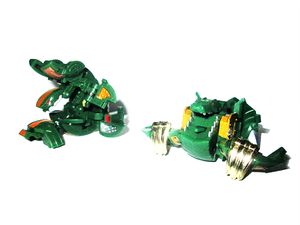
Five of the six attributes have color schemes that are similar with the BakuTech series or their associated attributes. The most notable example is Pyrus Rekka Hiryu which has its color scheme notably resembling the Dragaon series. The odd one out is the Subterra Koppa Kudaku which has army green as its predominant color that is similar to the color scheme of Subterra Ken Panzer rather than the usual shades of brown that are used in association with the earth element.
Size
Each Bakugan Armor is 32mm (3.2cm) in diameter when closed. It is of the same size as a typical B2-sized Bakugan.
Instruction
Each Bakugan Armors come with an instruction manual printed in glossy black and white paper. The manual has three parts. The first part shows the direction on how to properly close the Bakugan with the fastest time possible. The second part explains the Armor Change system, giving emphasis on the removal and installation of arm parts with concise illustrations. The last part expounds on the Usable Skill of the Bakugan's default Skill Arm.
List of Bakugan Armors Products
Booster Packs
- BAB-01 Pyrus Rekka Hiryu
- BAB-02 Ventus Shippu Zeku
- BAB-03 Aquos Hado Kaio
- BAB-04 Haos Ogon Houoh
- BAB-05 Subterra Koppa Kudaku
- BAB-06 Darkus Yasha Tagaras
BakuShop Exclusives
- BPAM-01 Translucent Haos Ikki Tosen
Trivia
Bakugan Armors is the shortest-lived series with only seven releases before it ended in May, 2014.
